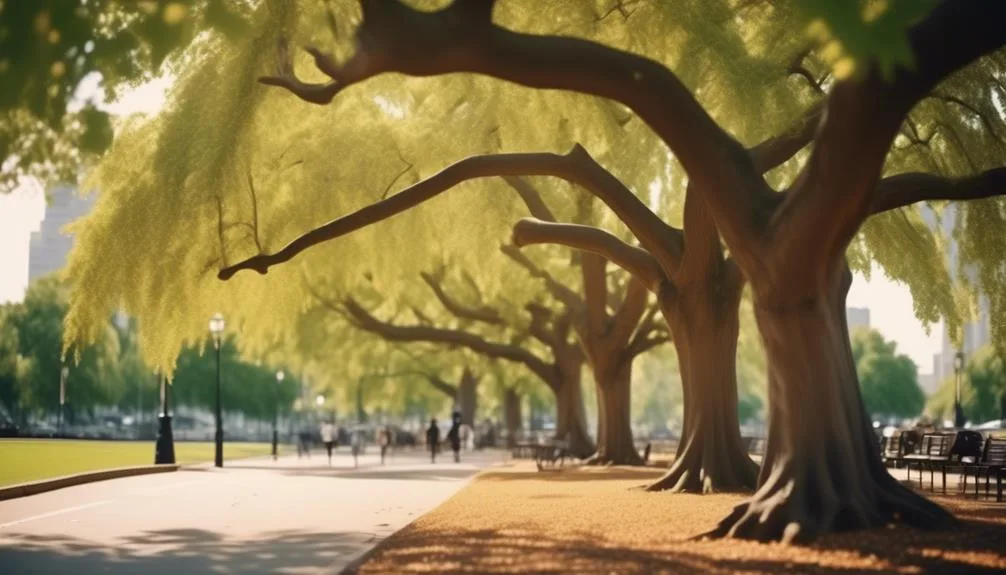In urban green spaces, elm trees play a vital role in creating a healthier environment. They help reduce urban heat and provide homes for various wildlife.
Their importance goes beyond looks. Discover how elm trees contribute to urban well-being and the challenges they face in changing city landscapes.
Benefits of Elm Trees in Urban Areas
In urban areas, elm trees provide numerous benefits, enhancing the environment and contributing to the well-being of the community.
These majestic trees play a crucial role in improving urban air quality by absorbing pollutants and releasing oxygen. As a result, they help to mitigate the impact of vehicle emissions and industrial activities, creating a healthier living environment for residents.
Additionally, elm trees promote community engagement by providing shaded areas for social gatherings, picnics, and outdoor activities. Their presence in urban green spaces encourages people to connect with nature, fostering a sense of belonging and pride in the local community.
Elm Tree Varieties Suitable for Urban Planting
Consider the diverse elm tree varieties that thrive in urban environments, each with unique characteristics suited for planting in city landscapes.
When selecting elm trees for urban landscaping, it's crucial to choose varieties that can withstand the challenges of urban development. The Princeton American Elm, known for its resilience to urban conditions, is an excellent choice, with its arching form and vibrant green leaves.
Additionally, the Accolade Elm, a hybrid variety, is highly resistant to Dutch elm disease and thrives in urban environments.
For areas with limited space, the Frontier Elm, with its narrow form, is a suitable option.
These elm tree selections not only enhance the aesthetic appeal of urban areas but also contribute to the overall well-being of city environments, making them ideal for urban tree planting initiatives.
Maintenance and Care of Elm Trees in Urban Green Spaces
To maintain and care for elm trees in urban green spaces, regularly inspect the foliage and branches for signs of disease or stress. Proper pruning techniques and watering schedules are essential for the health and longevity of these trees. When pruning, focus on removing dead or diseased branches to promote new growth and maintain a strong structure. Additionally, ensure that the soil around the elm tree is consistently moist but well-drained, especially during hot and dry periods. Here's a helpful table to guide you in the maintenance and care of elm trees:
| Maintenance Tips | Frequency |
|---|---|
| Inspect foliage | Weekly |
| Prune dead branches | Annually |
| Watering | Bi-weekly |
Elm Trees' Contribution to Urban Biodiversity
Amidst the urban landscape, elm trees play a vital role in fostering biodiversity and supporting a thriving ecosystem.
Elm tree species contribute significantly to urban wildlife habitats by providing shelter, food, and nesting sites for various species. The presence of elm trees also enhances tree diversity within urban green spaces, creating a more balanced and resilient urban ecosystem.
These trees attract a wide array of insects, birds, and small mammals, further enriching the urban biodiversity. By supporting diverse plant and animal life, elm trees contribute to the overall resilience of urban ecosystems, helping them better withstand environmental challenges.
Their presence not only adds beauty to urban areas but also plays a crucial role in maintaining a healthy and balanced natural environment within city landscapes.
Challenges and Solutions for Elm Trees in Urban Settings
In urban settings, elm trees face various challenges that require effective solutions to ensure their longevity and contribution to the urban ecosystem. One of the primary challenges is disease resistance in the urban environment. Elm trees are susceptible to diseases such as Dutch elm disease, which can devastate entire populations if left unchecked. To address this, urban planners and arborists are developing disease-resistant elm varieties to safeguard these trees. Another challenge is growth management, particularly concerning root systems. In urban areas, limited space can lead to conflicts between tree roots and infrastructure. Utilizing innovative root management techniques, such as structural soil systems and root barriers, helps to promote healthy tree growth while minimizing damage to infrastructure.
| Challenges | Solutions |
|---|---|
| Disease resistance | Develop disease-resistant elm varieties |
| Growth management, root systems | Implement structural soil systems and root barriers |
Conclusion
In urban green spaces, elm trees offer invaluable benefits, contribute to biodiversity, and enhance the environment's beauty.
Choosing suitable varieties, providing proper care, and addressing challenges are essential for cities to continue reaping these advantages.
Next time you stroll through a city park or along a tree-lined street, take a moment to acknowledge the vital role of elm trees in urban settings and their impact on the overall well-being of our communities.

My interest in trees started when I first saw the giant sequoias in Yosemite.
I was a teenager then, and I remember thinking, “I need to learn more about this.”
That moment stuck with me.
A few years later, I went on to study forestry at Michigan Tech.
Since graduating, I’ve worked in a mix of hands-on tree care and community education.
I’ve spent over ten years helping people understand how to plant, maintain, and protect the trees in their neighborhoods.
I don’t see trees as just part of the landscape.
They are living things that make a real difference in our daily lives.
